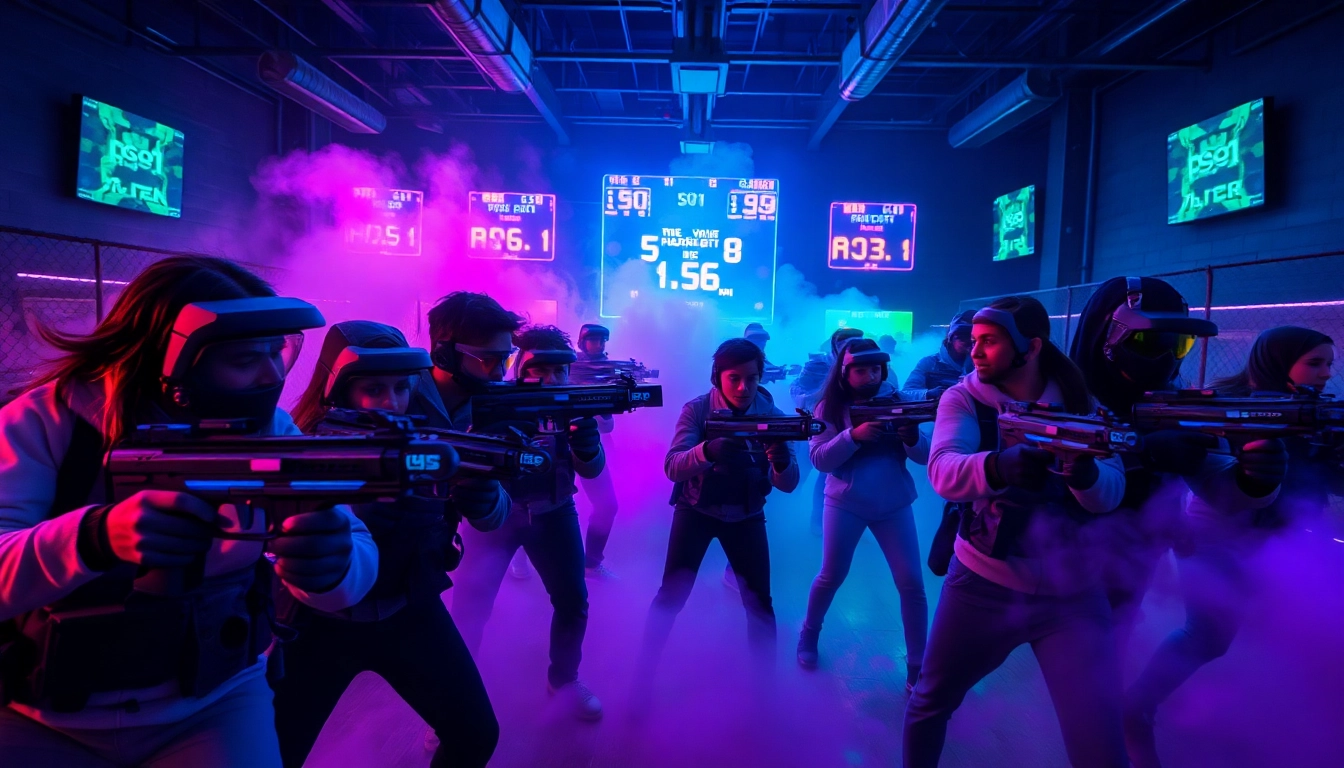An Introduction to Laser Tag
Laser tag is an exhilarating recreational activity that combines strategy, skill, and a dash of competitiveness, attracting enthusiasts of all ages. This exciting game enables players to engage in a thrilling showdown, using infrared-emitting light guns to ‘tag’ opponents within a designated play area. Each match is a blend of strategy and adrenaline-pumping action, offering players an immersive experience that fosters both physical and mental engagement. Whether you’re planning a birthday party, corporate event, or simply looking for a fun outing with friends, participating in laser tag can be an unforgettable experience.
What is Laser Tag?
Essentially, laser tag is a team-based game that simulates combat scenarios, akin to paintball but without the mess or pain associated with paint projectiles. Players are equipped with laser guns, often referred to as taggers, which emit harmless infrared beams. The objective is simple: aim, shoot, and score points by hitting targets worn by the opposing team or scattered throughout the arena. This fast-paced, action-packed activity is designed to test a player’s agility, tactical thinking, and teamwork.
How Laser Tag Works
Gameplay typically unfolds in a controlled environment, such as a darkened arena filled with obstacles, hiding spots, and themed decorations. Players are instructed on the rules and equipped with the necessary gear before each match. The basic mechanics involve players attempting to evade being tagged while strategizing ways to tag their opponents. Most systems track hits and provide feedback on a player’s performance, enhancing the competitive experience. After the match, players gather to review scores, which can often lead to discussions on strategies and tactics for future battles.
History and Evolution of Laser Tag
Laser tag’s origins trace back to the late 1970s and early ’80s when it was initially conceptualized as a military training tool. The first laser tag game for public entertainment was launched in the early 1980s, quickly gaining popularity. As technology advanced, so did the equipment and gameplay mechanics, leading to various adaptations of the game—from tactical experiences resembling military operations to fun family-friendly versions suitable for younger audiences.
Benefits of Playing Laser Tag
Physical Fitness and Coordination
One of the primary benefits of laser tag is its ability to promote physical fitness. Players engage in active movement, often running, dodging, and strategizing against opponents. This not only encourages cardiovascular health but also aids in improving coordination and agility. The nature of the game can lead to a significant calorie burn, making it a fun way to stay active without the tediousness that often accompanies traditional workouts.
Cognitive Skills and Strategy Development
Beyond physical activity, laser tag significantly enhances cognitive skills. Players must think critically and plan their moves, analyzing opponents’ behaviors and predicting their actions. This mental engagement fosters strategic thinking, quick decision-making, and problem-solving skills—competencies that extend beyond the gaming arena. Studies have shown that activities involving strategic gameplay can lead to improved concentration and cognitive flexibility in everyday life.
Social Interaction and Teamwork
Laser tag is not just about competition; it serves as a perfect platform for social interaction and teamwork. Players must work cooperatively to execute strategic plays and achieve their goals, fostering a sense of camaraderie and collective achievement. This social aspect is beneficial for team building in corporate settings or strengthening bonds within families and friend groups, highlighting the game’s versatility as a social activity.
Choosing the Right Laser Tag Experience
Types of Laser Tag Venues
When selecting a venue for laser tag, players can choose from various options, including indoor arenas designed specifically for laser tag, outdoor paintball fields adapted for laser tag, and mobile laser tag setups. Each venue offers a unique experience, with indoor arenas typically providing themed environments that enhance gameplay. Outdoor venues may offer larger spaces and different scenarios, while mobile setups can be used for private parties and events, bringing the fun directly to participants.
Equipment and Technology in Laser Tag
The equipment used in laser tag has evolved significantly, integrating advanced technology for a more refined gaming experience. Modern laser tag systems include lightweight, ergonomic guns featuring accurate targeting systems and adjustable settings for different player preferences. Additionally, some venues employ computerized scoring systems that track individual player scores in real-time, adding an element of competition and engagement.
Tips for First-Time Players
For those new to laser tag, it can be overwhelming at first. Here are a few tips to enhance your experience:
- Learn the Basics: Understand the rules and objectives before entering the arena. Most venues provide a briefing session before gameplay.
- Communicate with Your Team: Effective communication is crucial for successful gameplay; strategize with your teammates and share information about opponents.
- Stay Low and Move Quickly: Utilize the environment for cover and remain agile to evade being tagged while positioning yourself effectively to tag opponents.
- Practice Makes Perfect: Like any skill, your performance will improve with practice. Don’t hesitate to engage in multiple games to refine your strategies and techniques.
Pricing and Packages for Laser Tag
Cost Breakdown for Different Experiences
Understanding the pricing of laser tag experiences can help players budget for their outing. Prices can vary widely based on location, time of week, and additional services offered. Here’s a breakdown of common pricing:
- Single Game: A standalone game generally costs between $7 and $12 per person.
- Two Games Package: This option usually ranges from $12 to $20 per person, presenting a value for those looking to play multiple matches.
- Unlimited Play: Some venues offer an all-you-can-play option for a higher fee, typically ranging from $20 to $35 per person, allowing players to participate in as many games as they wish for a set duration.
Group Rates and Birthday Packages
Many laser tag venues offer discounted group rates, making them an excellent choice for birthday parties, corporate events, or family outings. Package deals often include food, drinks, and even party rooms, allowing for a seamless hosting experience. It’s recommended to inquire about custom packages tailored to specific needs, which can further enhance the overall experience.
Discount Deals and Membership Benefits
To encourage repeat visits, various laser tag venues provide special promotions, discounts, and membership benefits. Regular players may benefit from loyalty programs that offer members-only pricing, early bookings for events, and special access to new games or equipment releases. Always check for seasonal offers or group discounts that can significantly lower the cost by planning strategically.
Laser Tag Safety and Guidelines
Age Recommendations and Restrictions
Laser tag is designed to be a safe activity for a wide range of ages, typically recommended for children aged six and older. However, it’s important to check the specific venue’s policies, as some may have different age restrictions or equipment size considerations. Engaging young children can require adult supervision to ensure a safe and enjoyable experience.
Health Considerations During Gameplay
While laser tag is a fun and active experience, players should be mindful of health considerations, especially for individuals with specific medical conditions. It’s advisable to consult with a doctor if you have pre-existing health issues that could be exacerbated by vigorous activity. Staying hydrated and taking breaks during extended gameplay can also enhance overall enjoyment and safety.
Etiquette in the Arena
Ensuring everyone has a good time during laser tag requires adherence to certain rules of etiquette. Players should be respectful of opponents and teammates, refraining from aggressive behavior or unsportsmanlike conduct. Additionally, following the rules presented during the pre-game briefing is essential for maintaining a safe and enjoyable environment for all participants. Lastly, avoiding physical contact and respecting the arena equipment will help create a better experience for everyone involved.



